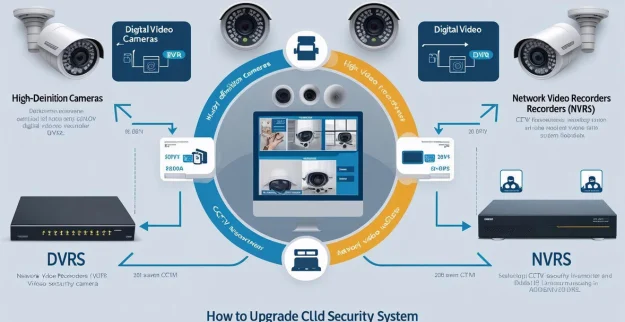How to Upgrade an Old CCTV Setup?

Security technology has evolved rapidly in recent years. If you're still relying on an outdated CCTV system, you may be missing out on improved image clarity, smarter features, and better remote access. Whether you’re a homeowner or managing business premises, upgrading your CCTV setup can significantly boost your security and peace of mind.
In this blog, we’ll guide you through key considerations and steps involved in upgrading an old CCTV system effectively.
1. Evaluate Your Current System
Before jumping into a new purchase, assess what you currently have:
- ▪️Type of Cameras: Are they analog or IP-based?
- ▪️Resolution: Older systems typically offer lower video quality.
- ▪️Storage Method: Are you using DVRs or cloud-based storage?
- ▪️Remote Access: Can you monitor feeds from a mobile device or remote location?
This evaluation will help you identify gaps and determine what needs to be replaced versus what can be upgraded or reused.
2. Define Your Surveillance Goals
What do you want your upgraded system to achieve? Consider:
- ▪️Wider area coverage
- ▪️Night vision capabilities
- ▪️Facial recognition or license plate capture
- ▪️Integration with alarms or access control systems
- ▪️Better mobile or remote access
Your goals will guide your equipment choices and design layout.
3. Switch from Analog to IP Cameras
One of the biggest upgrades you can make is shifting from analog to IP (Internet Protocol) cameras. Here's why:
- ▪️Higher Resolution: Most IP cameras offer Full HD, 4K, or even higher resolution.
- ▪️Remote Access: You can view footage from any location via apps or web browsers.
- ▪️Advanced Features: Motion detection, smart alerts, AI-based analytics, and more.
If you want to retain your existing coaxial cabling, consider using HD-over-Coax cameras (like HD-TVI or HD-CVI), which support higher resolutions while keeping the wiring in place.
4. Upgrade Your Recording System (DVR/NVR)
Outdated DVRs might not be compatible with high-resolution footage. For an IP-based setup, you’ll need a Network Video Recorder (NVR) instead of a DVR.
Modern NVRs come with:
- ▪️Larger storage capacity
- ▪️Video compression (e.g., H.265) for better efficiency
- ▪️Remote viewing support
- ▪️Integration with smart analytics
Also, consider cloud storage as a backup or primary solution for added flexibility and security.
5. Improve Cabling and Power Supply
Poor or degraded cables can reduce image quality or cause intermittent camera failures. As part of your upgrade:
- ▪️Replace old coaxial cables with Cat5e or Cat6 Ethernet cables for IP systems.
- ▪️Ensure a stable and dedicated power supply, possibly upgrading to PoE (Power over Ethernet) for easier cable management.
- ▪️Use surge protectors or UPS systems to avoid downtime during power outages.
6. Expand and Optimize Camera Placement
Take this opportunity to re-evaluate your camera layout:
- ▪️Cover all entry/exit points
- ▪️Monitor blind spots and vulnerable areas
- ▪️Adjust mounting angles for better visibility
- ▪️Consider adding PTZ (Pan-Tilt-Zoom) cameras for flexible coverage
Also, don’t forget to add weatherproof cameras for outdoor areas and infrared night vision or color night vision for low-light zones.
7. Add Smart Features and Integrations
Modern CCTV systems can do much more than just record:
- ▪️AI Motion Detection – Distinguishes between people, vehicles, and animals
- ▪️Line Crossing and Intrusion Alerts – Useful for perimeter security
- ▪️Mobile Notifications – Get alerts directly to your phone
- ▪️Integration with Alarms or Smart Home Systems – Centralize control for better efficiency
These features turn your CCTV into an intelligent surveillance system, offering both convenience and enhanced protection.
8. Ensure Cybersecurity Measures
Upgraded systems often rely on internet connectivity, making them vulnerable to cyber threats. Secure your system by:
- ▪️Changing default usernames and passwords
- ▪️Regularly updating firmware and software
- ▪️Using firewalls and network segmentation
- ▪️Avoiding unknown apps or software integrations
Cybersecurity should never be an afterthought in a modern CCTV setup.
9. Hire a Professional (If Needed)
While DIY upgrades are possible, professional installers can offer:
- ▪️Proper installation and wiring
- ▪️Optimal camera positioning
- ▪️Seamless integration with existing infrastructure
- ▪️Technical support and maintenance plans
Especially for commercial spaces or larger properties, this investment ensures your upgraded system performs at its best.
Conclusion
Upgrading an old CCTV setup is a smart move to strengthen your security, enhance video quality, and gain access to modern features. Whether it's replacing analog cameras with IP models, improving storage options, or integrating smart analytics, each step contributes to a more efficient and secure surveillance system.